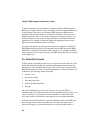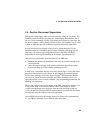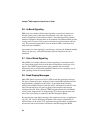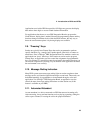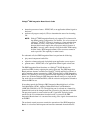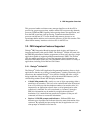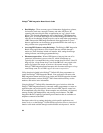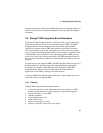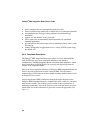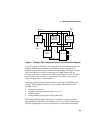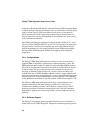Dialogic
®
PBX Integration Board User’s Guide
• detect the presence of tones - DTMF, MF, or an application-defined signal or
dual tone
• perform call progress analysis (CPA) to determine the state of an incoming
call
NOTE: Dialogic
®
PBX Integration Boards only support CPA when used in
the default routing configuration. For instance, if a voice resource of
a Dialogic
®
D/82JCT-U Board is listening to a front end other than
the default (its own), it may return a disconnected result. This is
because these boards support the call progress analysis feature of
dx_dial( ), but only when a board is using the default TDM routing.
In other words, PBX Integration Board voice resources cannot be
used to provide CPA capability for other boards.
For outbound calls, the PBX Integration Board can perform the following:
• play stored compressed audio files
• adjust the volume and speed of playback upon application or user request
• generate tones - DTMF, MF, or an application defined signal or dual tone
The PBX Integration Board functions as a Dialogic
®
D/41D Board with
specialized PBX circuitry replacing the analog front end. The PBX Integration
Board performs features available on a Dialogic
®
D/41D and D/42-xx Board, as
well as emulates phones connected to a PBX. With the D/42-xx PBX Integration
Boards, it is necessary to choose a particular board depending on which PBX you
plan to use. With the Dialogic
®
PBX Integration Board, however, a single board
can work with several different PBXs, with the software configuration selected to
reflect the PBX in use.
If recording speech, the Dialogic
®
PBX Integration Board digitizes it as Pulse
Code Modulation (PCM), Adaptive Differential Pulse Code Modulation
(ADPCM), GSM 610, or G.726. The digitizing rate is selected on a channel-by-
channel basis and can be changed each time a record or play function is initiated.
The processed speech is stored on the host PC’s hard disk. If playing back a
stored file, the voice information from the host PC is passed to the PBX
Integration Board where it is converted into analog voice signals for transmission
to the PBX.
The on-board control processor controls the operations of the PBX Integration
Board via a local bus and interprets and executes commands from the host PC.
28



